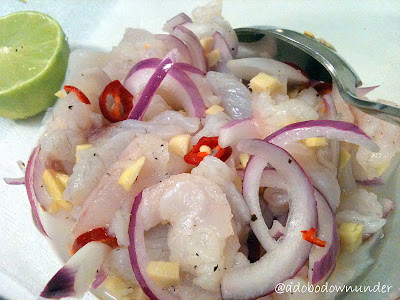Learning kitchen skills was one of the things I looked forward to when I started my course in Kitchen10. And filleting a fish was one of the highlights last year. Right up there in the top 3. Its not easy, but with the right equipment (a filleting knife) and a lot of practice, it can be a breeze! I’ve tried doing it at home more than a dozen times already. But when I’m head to head with a fish, it still gets kind of intimidating! Those nano seconds can get really entertaining, but we get on and fast forward a few minutes after, voila. We have a significant amount of flesh to consume. So I did not completely mess the fish after all.
This is so easy to prepare. 15 minutes, tops! If and when you find yourself in the Masterchef kitchen and there's that 10 or 20 minutes pressure test, this simple, fast and furious dish should be one of those up your sleeves. Just don't put too much chillies or it'll make George sweat up a storm.
To make this simple snapper kinilaw or ceviche, ask your fishmonger to fillet the fish for you. Half of the job is done already.
Fillet of 1 medium sized snapper, sliced thinly or strips
Half of red onion, sliced
2 knobs (thumb-sized) ginger, diced
1 birds eye chilli, chopped
Juice of half a lime
60ml or ¼ cup white vinegar
Salt and pepper to season (optional)
In a medium sized bowl, stir the ingredients together. Add the fish slices and stir gently to coat the fillets. Let the fish soak for 5-10 minutes.
You can opt to serve the fish with the vinegar mixture or without it.
You can make a bigger serve of this, with a bigger fish. Just let your taste buds guide you with the marinade. As a rule, the vinegar should just be enough to soak all the fish, not to cover them completely.
Make this a few minutes before you intend to serve them. As the longer the fish soaks, the more its cooked by the acid in the vinegar. And the longer it’s soaked, the flesh gets flaky and will not be as good.
In the Philippines, the fish variety locally called “tanigue” (also known as seer fish or wahoo) is used to make this dish. But because this one is made in Australia, I’ve used whatever is the locally available white-flesh fillet variety. I’ve never tried making this dish with other fish varieties, but in various parts of the Philippines, kinilaw or ceviche can also be prepared using fresh anchovies and oysters.
This is a Filipino appetizer, usually served where beer is on the menu. Add some rounds of karaoke there, and you’re definitely in Pinoy surrounds.
Here’s a useful link about varieties of fish and general cooking method.




Sounds delicious, I haven't tasted ceviche for ages! So fresh.
ReplyDeleteThanks @bizzylizzy'sgoodthings! Maybe time to make some today?! :D
DeleteNice! I just bought a whole snapper today, you must be reading my mind!
ReplyDeleteThanks @Sefie! Go ahead and make ceviche! Its refreshing, especially with a really fresh fish!
DeleteDelicious, simple recipe that highlights the fresh fish! Thanks for stopping by my site! Your site is great- I just added you to my blogroll. Are you on Instagram or Facebook?
ReplyDeleteThanks Sonali! I'm humbled to be included in your blog roll! I'm following you on instagram!
DeleteI love ceviche! This looks really good! I'm wondering if I can put some chopped cilantro in it too?
ReplyDeleteHi @Red Shallot! Coriander (the local name for cilantro) are me new love! I can't get enough of them! Yes! They would definitely work with the ceviche! Will try them too next time!
Deletewow..lovely presentation with great flavors.
ReplyDeletejust found your space..awesome space you have..
nice presentation with inviting cliks..
Am your happy follower now..:)
do stop by mine sometime..
Tasty Appetite
Thanks for the lovely comments @Jay.
DeleteTanigue is also used to describe Spanish mackerel in the Philippines so this can be used also.
ReplyDeleteKingfish, Trevally and many similar fish will be good also